One to one maths interventions built for KS4 success
Weekly online one to one GCSE maths revision lessons now available
In order to access this I need to be confident with:
Rearranging formulae Solving equations Reciprocal maths Plotting graphsThis topic is relevant for:

Parallel And Perpendicular Lines
Here we will learn about parallel and perpendicular lines including how to show when two lines are parallel or perpendicular, how to calculate the gradient of parallel and perpendicular lines and use this knowledge to calculate the gradient of tangents to circles.
There are also parallel and perpendicular worksheets based on Edexcel, AQA and OCR exam questions, along with further guidance on where to go next if you’re still stuck.
What are parallel and perpendicular lines?
Parallel lines are straight lines with a constant distance between them.
Perpendicular lines intersect one another at a
E.g.
A table has
Straight line graphs can be parallel, perpendicular or have
What are parallel and perpendicular lines?
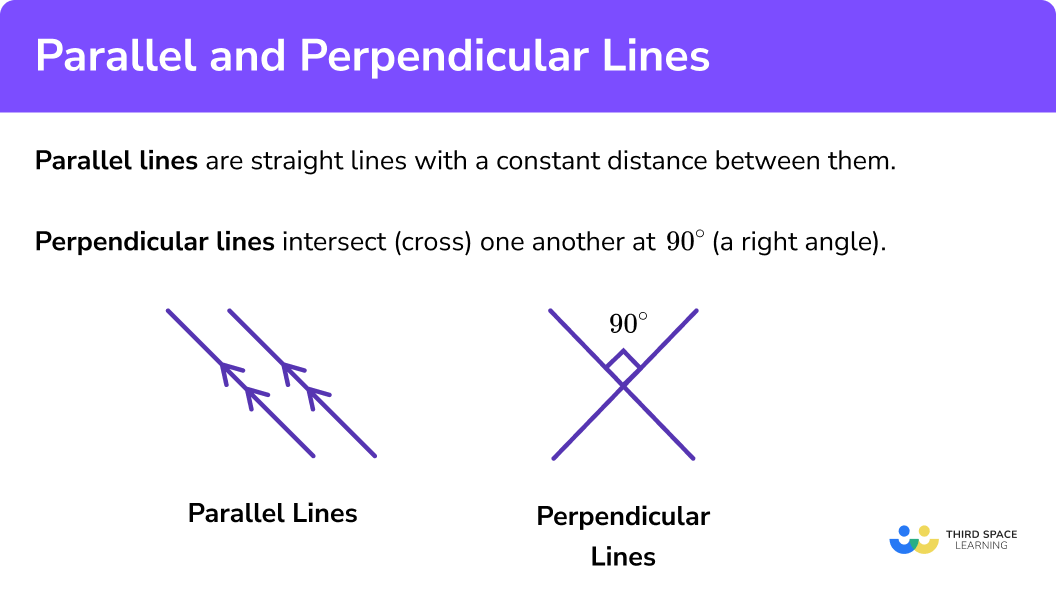
Parallel lines
Two (or more) straight lines are parallel when they share the same gradient.
E.g.
Let’s look at the three lines
Each straight line has the same gradient (here,
We can therefore state that the equation of a line parallel to a line with the gradient
Top Tip: All vertical lines are parallel to the line
What are parallel lines?
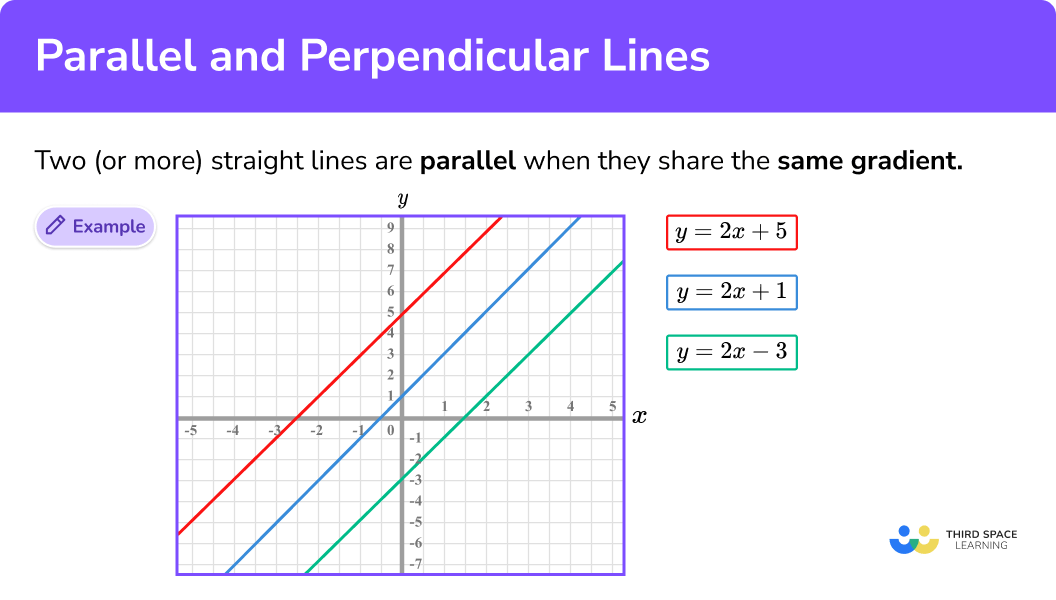
Equations of parallel lines
Parallel lines can be recognised by their equations by checking if their gradients are the same. This may require some rearranging.
E.g.
Show that y=-2x+4 and 4x+2y=9 are parallel.
The gradient of the first line is -2. We need to rearrange the second equation so that it is in the form y=mx+c so we can find the gradient.
4x+2y=9 2y=-4x+9 y=-2x+4.5
The gradient of the second line is also -2. The gradients of the two lines are the same, so the lines are parallel.
Perpendicular lines
Perpendicular lines have gradients that multiply to give
In other words, the gradients of two lines that are perpendicular to each other are the negative reciprocals of each other.
E.g.
To see why let’s look at the line
The gradient of the line
Let’s now construct a line that is perpendicular to the line
The equation of a straight line that is perpendicular to the line
We can see that the gradient of each line has a different sign (one has a positive gradient whilst the other has a negative gradient).
To find out what is going on here let’s look at a second example.
E.g.
Take the line
Let’s construct a perpendicular to the line
Here the equation of the line that is perpendicular to y = 2x + 3 at the point (0, 3) is y=−\frac{1}{2}x+3
We can still state that the gradients change from being positive to negative but we now have the gradient of -\frac{1}{2} which is the negative reciprocal of 2 .
Let us look at the previous two examples together in the table below:
| Gradient of line 1 | Gradient of line 2 | Product of both gradients |
| 1 | -1 | 1 × (-1) = -1 |
| 2 | -½ | 2 × -½ = -1 |
Here we can see that the product of the gradients of each line is equal to
We can therefore state that for any two perpendicular lines
If we divide both sides of the formula by
The value of
What are perpendicular lines?
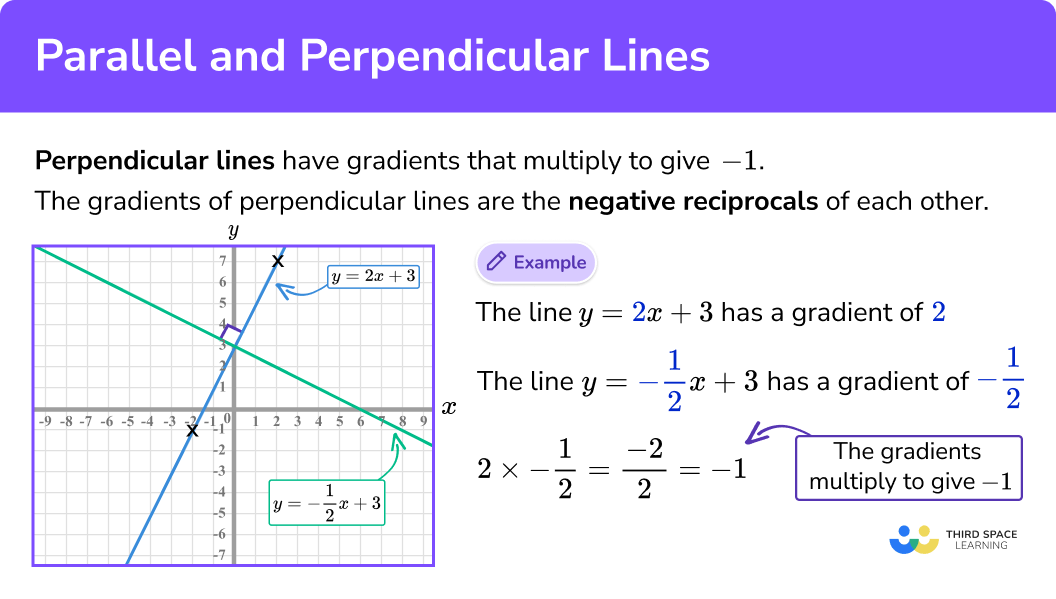
Gradients of parallel and and perpendicular lines
The gradients of parallel lines are the same.
The gradients of perpendicular lines multiply together to make -1.
Here is a brief summary.
For any two lines to be parallel, the gradient is the same for each line.
E.g.
y = 5x + 3 and y = 5x − 9 are parallel as the gradient for each line is 5.
For any two lines to be perpendicular, the product of their gradients must equal −
E.g.
y=4x+7 and y=-\frac{1}{4}x+9 are perpendicular as 4\times-\frac{1}{4}=-1
How to find the equation of a parallel line
In order to find the equation of a parallel line:
- State/calculate the gradient of the original straight line.
- Substitute the value for
m into the equation of a new straight line. - State/calculate the value of the \textbf{y} -intercept.
How to find the equation of a parallel line
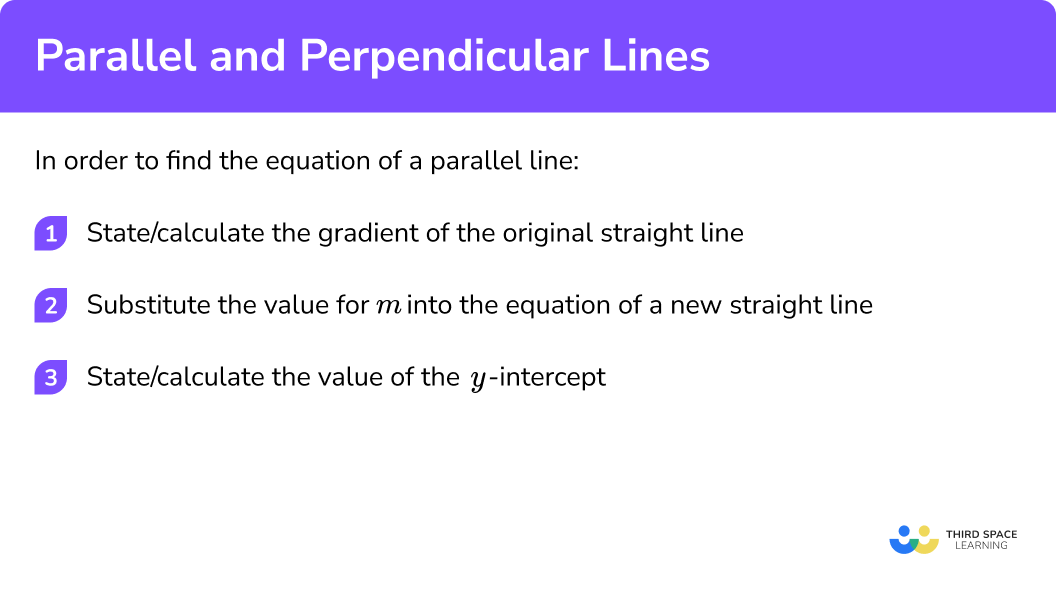
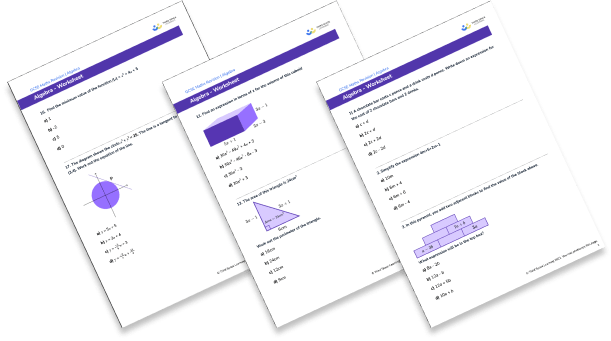
Parallel and perpendicular lines worksheet

Get your free parallel and perpendicular lines worksheet of 20+ questions and answers. Includes reasoning and applied questions.
DOWNLOAD FREE
Parallel and perpendicular lines worksheet

Get your free parallel and perpendicular lines worksheet of 20+ questions and answers. Includes reasoning and applied questions.
DOWNLOAD FREERelated lessons on straight line graphs
Parallel and perpendicular lines is part of our series of lessons to support revision on straight line graphs. You may find it helpful to start with the main straight line graphs lesson for a summary of what to expect, or use the step by step guides below for further detail on individual topics. Other lessons in this series include:
Parallel lines examples
Example 1: write the equation of a parallel line (algebraically)
The equation of a line A is given as 5y = x − 10 .
Write the equation of a line that is parallel to A .
- State/calculate the gradient of the original straight line.
As 5y=x-10 .
Here, the gradient of the line is \frac{1}{5}
2Substitute the value for
Substituting m=\frac{1}{5} into a new equation, we get y=\frac{1}{5}x+c
3State/calculate the value of the y-intercept.
Here we are asked to state a parallel line so any value of
An example of an equation of the line parallel to line A is y=\frac{1}{5}x+3
Example 2: write the equation of a parallel line (graphically)
The line B is drawn on a set of axes. Write the equation of a line that is parallel to B.
State/calculate the gradient of the original straight line.
Here,
Substitute the value for m into the equation of a new straight line.
We now have
State/calculate the value of the y-intercept.
Here we are asked to state a parallel line so any value of
A possible solution would be
Example 3: given 1 coordinate and the gradient
Two lines, D and E are written in the form
The gradient of the line D is equal to
The line E is parallel to D and goes through the point (
Work out the equation of line E.
State/calculate the gradient of the original straight line.
We know from the question that the gradient of line D is
Substitute the value for m into the equation of a new straight line.
We now have
State/calculate the value of the y-intercept.
We need to calculate the value of
The equation of line E is
How to calculate the equation of perpendicular lines
In order to find the equation of a perpendicular line:
- State/calculate the gradient of the original straight line.
- Calculate the negative reciprocal of the gradient.
- Substitute the negative reciprocal into the equation of a new straight line.
- State/calculate the value of the \textbf{y} -intercept.
How to calculate the equation of perpendicular lines
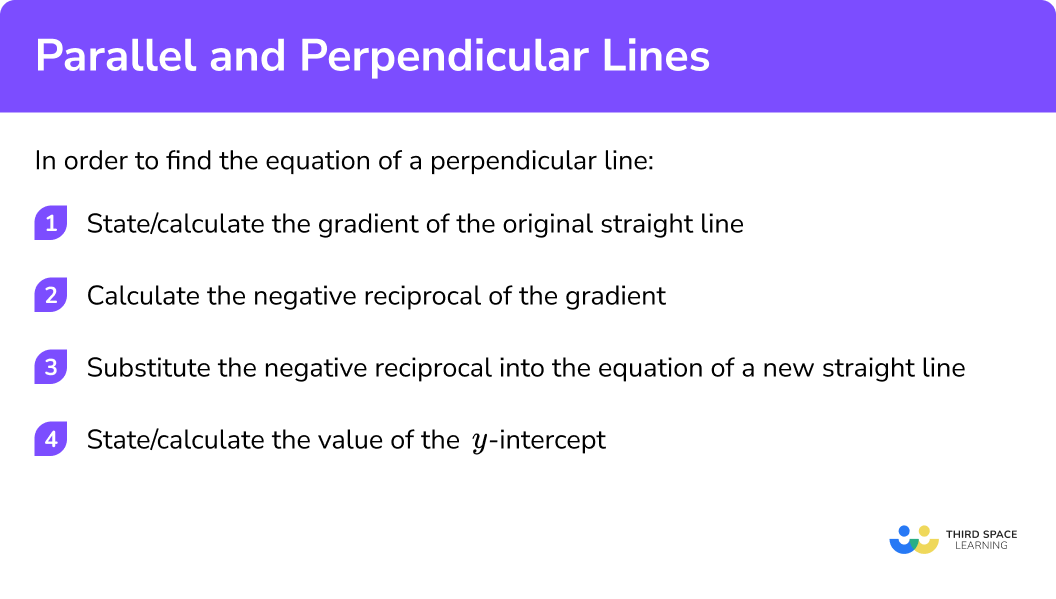
Perpendicular lines examples
Example 1: write the equation of a perpendicular line (algebraically)
The equation of a line A is given as
State/calculate the gradient of the original straight line.
First we need to rearrange the equation to make
Now we can see that
Calculate the negative reciprocal of the gradient.
The gradient of the line perpendicular to A is equal to
Substitute the negative reciprocal into the equation of a new straight line.
We now have the equation y=-\frac{1}{4}x+c for the line perpendicular to A.
State/calculate the value of the y-intercept.
Here, we are asked to state a perpendicular line so any value of
An example of an equation of the line perpendicular to line A is y=-\frac{1}{4}x+1
Example 2: write the equation of a perpendicular line (graphically)
The line B is drawn on a set of axes. Write the equation of a line that is perpendicular to B at the point (
State/calculate the gradient of the original straight line.
Here,
Calculate the negative reciprocal of the gradient.
The gradient of the line perpendicular to B is equal to
Substitute the negative reciprocal into the equation of a new straight line.
We now have the equation y=\frac{1}{2}x+c for the line perpendicular to B.
State/calculate the value of the y-intercept.
Here we have to substitute the coordinate (
The equation of the line that is perpendicular to the line B is y=\frac{1}{2}x+3\frac{1}{2} or 2y=x+7 .
Example 3: given 1 coordinate and the gradient
Two lines, D and E are written in the form
The gradient of the line D is equal to -\frac{2}{5} and intersects the y-axis at the origin. The line E is perpendicular to D. Work out the equation of line E.
State/calculate the gradient of the original straight line.
The gradient of line D is -\frac{2}{5} as stated in the question.
Calculate the negative reciprocal of the gradient.
Here, we have
Substitute the negative reciprocal into the equation of a new straight line.
Substituting m=\frac{5}{2} into y=mx+c we get y=\frac{5}{2}x+c
State/calculate the value of the y-intercept.
Here we have to substitute the coordinate (
The equation of line E is therefore y=\frac{5}{2}x
Common misconceptions
- Using the y-intercept instead of the coefficient of
x (parallel lines)
E.g.
Take example
After making
- Not/incorrectly rearranging to the form
y = mx + c
The gradient is the coefficient of
If the equation of a straight line is not written with
E.g.
Take example
Here, the value of the gradient could be incorrectly stated as
- The reciprocal vs the negative reciprocal
A common mistake is to state the gradient of the perpendicular to a line to be the reciprocal of the original gradient, and not the negative reciprocal.
If the negative reciprocal was not used his would mean that both lines would have a positive gradient, or they would both have a negative gradient. This would mean that although the two lines may intersect they will not intersect at
Practice parallel and perpendicular lines questions
1. Which equation is parallel to the line y=4x+3 ?




Any equation of the form y=4x+c for any value of c .
2. Which of the following equations is parallel to the line 2y-5=3x ?




Both have the gradient of 1.5 (or m=\frac{3}{2} )
3. Calculate the gradient of the line that is perpendicular to the line y=-0.4x+3 .




The product of the two gradients must equal -1 .
Here, -1\div-0.4 = 1\div0.4 = 2.5
4. Calculate the gradient of the line that is perpendicular to the line y=-\frac{7}{10}x+4




The product of the two gradients must equal -1 .
Here, \frac{-7}{10}\times\frac{10}{7}=\frac{-70}{70}=-1
5. State the equation of the line that is parallel to the line y=2x+7 at the point ( 3,8 )




The line must have a gradient of 2 so y=2x+c .
At the point ( 3,8 ), 8=2\times3+c , so c=2
Hence, y=2x+2
6. Calculate the equation of the line that is perpendicular to the line y=-\frac{1}{3}x+1 that intersects at the point ( 6,-1 )




New gradient = -1\div{-\frac{1}{3}}=-1\times{-3}=3
y=3x+c at the point ( 6,-1 ) means -1=(3\times6)+c
c=-19
Parallel and perpendicular lines GCSE questions
1. Two straight lines A and B are shown below. Prove that the lines are parallel.
(3 marks)
Gradient of line A = \frac{2−1}{2−0}=\frac{1}{2}
(1)
Gradient of line B = \frac{0−−2}{4−0}=\frac{2}{4}=\frac{1}{2}
(1)
Gradients are the same, therefore parallel
(1)
2. (a) Circle the equation of the line that is parallel to the y-axis.
| x=3 | x+y=0 | y=−1 | xy=4 |
(b) Use the straight line graph L below to write the equation of a parallel line passing through the coordinate ( 3,4 )
(4 marks)
a) x = 3
(1)
b) Gradient of line L is equal to − 1
(1)
y = −x + c(1)
4 = −3 + c so c = 7 or y = −x + 7
(1)
3. (a) The line P has the equation y=6−\frac{3}{5}x . Circle the gradient of a line that is perpendicular to P.
| −\frac{5}{3} | \frac{3}{5} | \frac{5}{3} | 5 |
(b) Point C (3,6) lies on a circle, centre O. The tangent at C intersects the axes at points A and B. Show that the gradient of the tangent is -\frac{1}{2}
(3 marks)
a) \frac{5}{3}
(1)
b) Gradient of OC= \frac{6}{3}=2
(1)
Gradient of perpendicular (tangent):
AB=−1\div2
AB=−\frac{1}{2}
(1)
4. Use the graph below to show that the two lines are parallel. Clearly state any conclusions.
(4 marks)
(2)
m=-\frac{6}{5} for both lines
(1)
The gradients are the same so the lines are parallel
(1)
Learning checklist
You have now learned how to:
- Identify horizontal and vertical lines and pairs of perpendicular and parallel lines.
- Use the form y = mx + c to identify parallel {and perpendicular} lines; find the equation of the line through 2 given points, or through 1 point with a given gradient.
The next lessons are
Still stuck?
Prepare your KS4 students for maths GCSEs success with Third Space Learning. Weekly online one to one GCSE maths revision lessons delivered by expert maths tutors.

Find out more about our GCSE maths tuition programme.